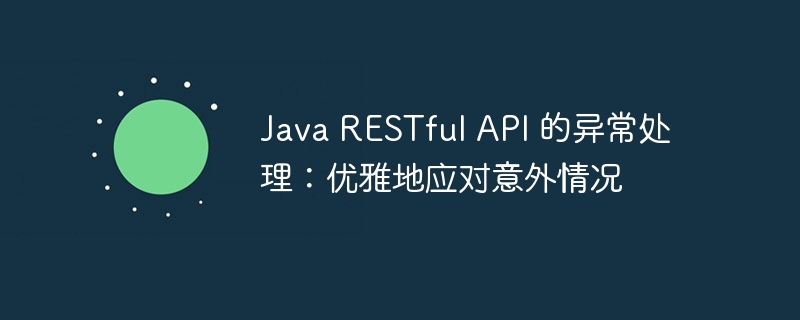 Java
Java
 javaTutorial
javaTutorial
 Exception handling for Java RESTful APIs: Dealing with unexpected situations gracefully
Exception handling for Java RESTful APIs: Dealing with unexpected situations gracefully
Exception handling for Java RESTful APIs: Dealing with unexpected situations gracefully
Mar 09, 2024 am 09:25 AM
Exception handling of Java RESTful API is an indispensable part of the development process. Proper handling of exceptions can improve system stability and user experience. In actual development, we often encounter various unexpected situations, such as request timeout, database connection failure and other problems. How to deal with these abnormal situations gracefully is a problem that every Java developer needs to think about and solve. This article will introduce some common exception handling methods to help developers better deal with unexpected situations and ensure the stability and reliability of system operation.
In RESTful api, exceptions are inevitable. To ensure application robustness and user experience, a common exception handling mechanism needs to be implemented. The following steps outline implementing a common exception handling mechanism:
-
Create a global exception handler: Write a global exception handler class that extends the
ResponseEntityExcept<strong class="keylink">io</strong>nHandlerclass. This class should override thehandleExceptionInternal()method to handle all unhandled exceptions. -
Define the exception response model: Create the
ErrorDet<strong class="keylink">ai</strong>lsclass to represent the exception response. This class should contain detailed information about the error, such as error code, error message, and optional error stack trace. -
Mapping exceptions: In the global exception handler, use the
@ExceptionHandlerannotation to map specific exceptions to custom handling methods. For example:
1 2 3 4 5 6 7 8 9 10 |
|
Custom exception handling
In addition to the general exception handling mechanism, custom exception handling can also be implemented for specific types of errors. This allows you to provide more detailed and relevant error messages. The following steps outline implementing custom exception handling:
- Create a custom exception class: Create a custom exception class that extends
RuntimeException. For example:
1 2 3 4 5 6 7 |
|
- Throw custom exceptions: In code, throw your custom exceptions as needed. For example:
1 2 3 |
|
- Mapping custom exceptions: In the global exception handler, use the
@ExceptionHandlerannotation to map custom exceptions to custom handling methods. For example:
1 2 3 4 5 6 7 8 9 10 |
|
Using Spring Boot and Spring MVC
In Spring Boot and spring mvc, you can use the exception handling function to simplify exception handling. The following steps outline how to use Spring Boot and Spring MVC for exception handling:
-
Add the
@RestControllerAdviceannotation: Add the@RestControllerAdviceannotation on the global exception handler class to make it part of Spring MVC exception handling. -
Return
ResponseEntity: In the exception handling method, returnResponseEntity<ErrorDetails>, whereErrorDetailsis the error response model.
in conclusion
Exception handling is a crucial part of RESTful API. By implementing a common exception handling mechanism and custom handling of specific types of errors, you can ensure that your application handles unexpected situations gracefully. By providing detailed and relevant error messages, you can also improve the user experience and simplify the debugging of your application.
The above is the detailed content of Exception handling for Java RESTful APIs: Dealing with unexpected situations gracefully. For more information, please follow other related articles on the PHP Chinese website!

Hot Article

Hot tools Tags

Hot Article

Hot Article Tags

Notepad++7.3.1
Easy-to-use and free code editor

SublimeText3 Chinese version
Chinese version, very easy to use

Zend Studio 13.0.1
Powerful PHP integrated development environment

Dreamweaver CS6
Visual web development tools

SublimeText3 Mac version
God-level code editing software (SublimeText3)

Hot Topics
 Break or return from Java 8 stream forEach?
Feb 07, 2025 pm 12:09 PM
Break or return from Java 8 stream forEach?
Feb 07, 2025 pm 12:09 PM
Break or return from Java 8 stream forEach?












